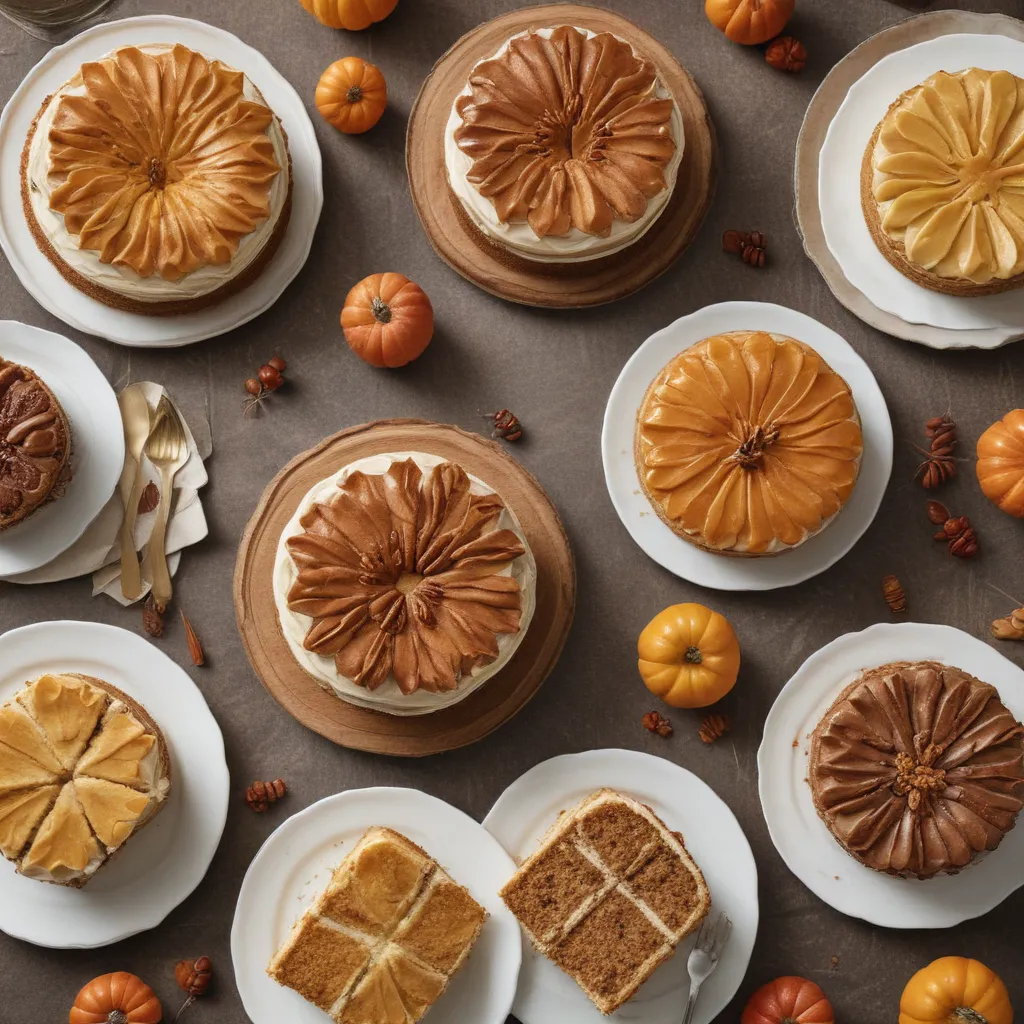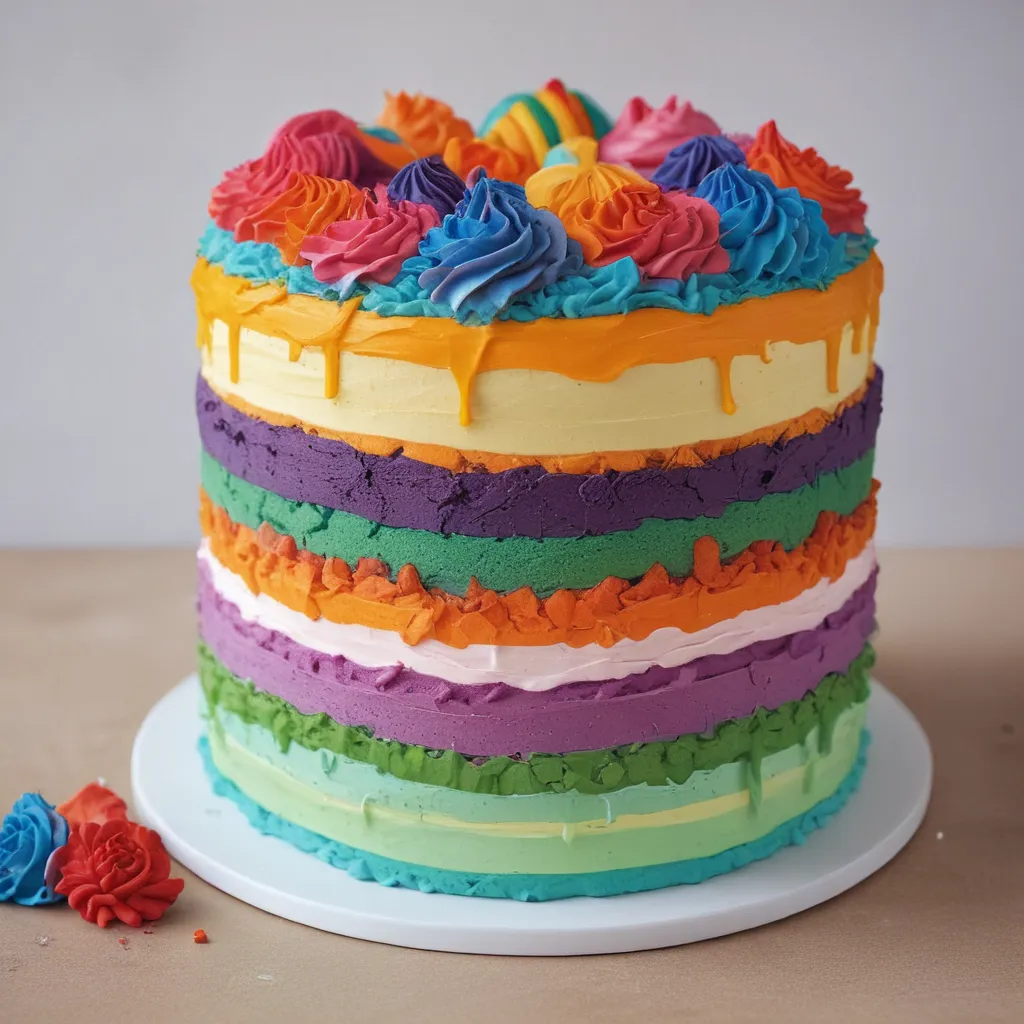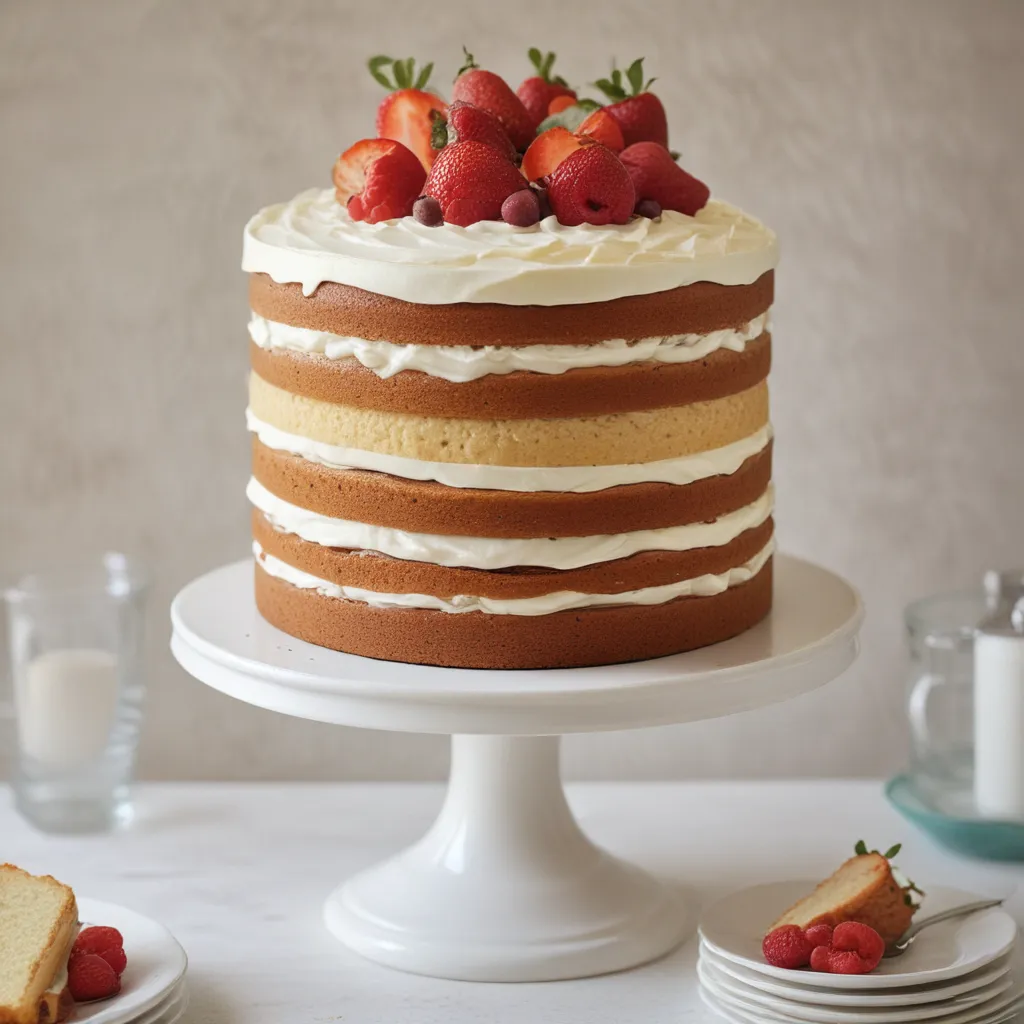The Alchemy of Flour, Sugar, and Eggs
As the owner of a beloved custom cake shop in the heart of San Jose, I’ve had the privilege of witnessing the sheer magic that happens when flour, sugar, and eggs come together. It’s a captivating dance of chemistry and physics, a symphony of flavors and textures that never fails to enchant both my customers and myself.
You see, baking is not just a culinary art – it’s a scientific exploration, a deep dive into the intricate world of molecular gastronomy. Every time I slip a tray of freshly mixed batter into the oven, I’m embarking on a journey of discovery, never quite sure what delectable delights will emerge. Will the cake rise to towering perfection, or will it fall flat like a sad soufflé? Will the frosting be silky smooth or grainy and clumpy? It’s a high-stakes game, where the slightest misstep can mean the difference between a masterpiece and a disaster.
But fear not, my fellow baking enthusiasts! In this article, I’m going to pull back the curtain on the science behind baking, revealing the inner workings of this delicious discipline. From the role of gluten in creating tender crumbs to the importance of temperature and timing, we’ll explore the fundamental principles that govern the art of cake making. So, grab a whisk and get ready to dive into the delectable world of baking science!
The Gluten Conundrum: Striking the Perfect Balance
At the heart of every successful baked good lies the humble gluten molecule. This intricate network of proteins is the backbone that gives structure and strength to our creations, but it’s a fickle beast that must be tamed with care and precision.
Let’s start by understanding the nature of gluten. When flour and water are combined, the proteins in the flour – glutenin and gliadin – interact to form gluten strands. These strands are what give bread its chewy texture and cakes their tender crumb. But here’s the catch: too much gluten development can lead to tough, dense baked goods, while too little can result in a crumbly, fragile mess.
The key, then, is to strike the perfect balance. In cakes, we want just enough gluten to provide structure and support, but not so much that it compromises the delicate, melt-in-your-mouth texture we crave. This is where the science of baking comes into play.
By carefully controlling the mixing and kneading process, we can encourage the right amount of gluten development. Gentle mixing and a light touch are the order of the day, as excessive agitation can cause the gluten to over-develop, leading to a tough, rubbery crumb. And when it comes to ingredients, the type of flour we choose can also make a significant difference. Soft, low-protein flours, such as cake flour, are better suited for delicate cakes, while the higher-gluten all-purpose flour is better suited for chewier baked goods.
It’s a delicate dance, this gluten tango, but with a little practice and a keen understanding of the science, we can master the art of creating the perfect cake texture, every single time.
The Temperature Tango: Baking’s Intricate Dance
Temperature, my friends, is the unsung hero of the baking world. It’s the invisible puppet master that pulls the strings, orchestrating the intricate dance of molecules and transformations that take place within our ovens.
Let’s start with the pre-heat. That’s right, the humble act of warming up the oven is a crucial step in the baking process. You see, the even distribution of heat is essential for ensuring that our baked goods cook through evenly, without any hot spots or uneven browning. And the temperature we choose? Well, that’s where the real magic happens.
Higher temperatures, in the range of 375°F to 425°F, are ideal for creating those delectable, golden-brown crusts that we all crave. The intense heat causes the sugars in the batter to caramelize, resulting in a tantalizing depth of flavor and a crisp, crackly exterior. But beware, dear bakers, for too much heat can lead to a dry, overbaked disaster.
On the other hand, lower temperatures, around 325°F to 350°F, are better suited for delicate cakes and pastries. This gentler heat allows the structure to develop slowly, ensuring a tender, moist crumb that melts in your mouth. It’s all about finding the sweet spot, the Goldilocks zone where the temperature is just right.
And let’s not forget about the importance of timing. Baking is a delicate dance, and the rhythm is crucial. Ovens can be fickle, and even the slightest deviation from the recommended baking time can mean the difference between a masterpiece and a flop. That’s why I always keep a watchful eye on my creations, constantly monitoring their progress and making adjustments as needed.
Temperature and timing, my friends, are the dynamic duo that hold the key to baking success. Master these two elements, and you’ll be well on your way to creating cakes that will have your customers swooning with delight.
The Egg Enigma: Unraveling the Secrets of the Humble Hen’s Treasure
Ah, the humble egg – nature’s most versatile ingredient and the cornerstone of any well-stocked baking pantry. But there’s more to this unassuming little oval than meets the eye. In fact, the science behind the egg is a veritable treasure trove of baking knowledge, just waiting to be unlocked.
Let’s start with the most fundamental role of the egg: structure. When baked, the proteins in the egg coagulate, forming a sturdy network that gives cakes and other baked goods their shape and stability. But the egg’s powers don’t stop there. It also acts as a tenderizer, helping to create a soft, tender crumb by inhibiting the development of gluten.
And then there’s the emulsifying power of the egg. The fat and water-soluble components of the egg work together to create a stable emulsion, which is essential for achieving the perfect, velvety smooth texture in batters and frostings. Without this magical emulsifying action, our cakes would be prone to separation, with unsightly pockets of oil or water ruining the overall appearance and mouthfeel.
But the real showstopper? The egg’s ability to create loft and rise. When beaten, the proteins in the egg whites expand and trap air, creating a light, airy structure that gives cakes their towering height and soufflés their ethereal lightness. It’s a delicate balance, though, as over-beating can lead to a dry, tough texture.
And let’s not forget the all-important role of egg yolks. These golden reservoirs of fat and emulsifiers are the key to achieving rich, moist cakes and the perfect velvety frosting. They’re the unsung heroes that add moisture, texture, and that luscious, indulgent mouthfeel we all crave.
So, the next time you crack those shells and whisk those whites, remember the science at play. The egg, my friends, is the unsung champion of the baking world, a true marvel of nature that deserves our utmost respect and appreciation.
The Sugar Sorcery: Unlocking the Magic of Sweetness
Ah, sugar – the sweet siren that lures us into the world of baking with its intoxicating allure. But this humble white granule is far more than just a flavor enhancer. In fact, it’s a veritable powerhouse of baking science, playing a crucial role in everything from texture to caramelization.
Let’s start with the basics. Sugar, in its various forms, helps to tenderize baked goods by interfering with the formation of gluten. The more sugar present, the less tough and chewy the final product will be. But that’s not all – sugar also helps to retain moisture, preventing our cakes and cookies from drying out and becoming crumbly.
But the real magic happens in the caramelization process. When exposed to heat, sugar undergoes a series of complex chemical reactions, transforming into a rich, golden-brown elixir that adds depth of flavor and a irresistible crunch. It’s the secret behind those perfectly golden-brown crusts and the delectable, caramelized edges of our favorite cookies.
And let’s not forget about the role of sugar in creating that oh-so-satisfying rise. When combined with leavening agents like baking soda or baking powder, sugar helps to create pockets of air that expand during baking, resulting in towering, light-as-air cakes and pastries.
But the sugar sorcery doesn’t stop there. This versatile ingredient also plays a crucial role in stabilizing foams, such as meringue and whipped cream. The sugar molecules help to strengthen the delicate protein structures, preventing them from collapsing and ensuring a light, airy texture.
So, the next time you reach for that bag of sugar, remember that you’re not just adding sweetness – you’re unlocking a world of baking magic. From tenderizing to caramelizing, this humble ingredient is the unsung hero of the baking world, a true alchemist’s delight.
The Butter Brilliance: Mastering the Art of Richness and Texture
Ah, butter – the very essence of richness and indulgence in the world of baking. This golden, creamy elixir is the secret ingredient that elevates our cakes and cookies from merely delicious to downright decadent. But there’s more to this beloved dairy product than meets the eye.
You see, butter is far more than just a fat. It’s a complex and multifaceted ingredient that plays a crucial role in both the texture and flavor of our baked goods. Let’s start with the all-important role of fat. When incorporated into our batters and doughs, butter coats the flour particles, inhibiting the formation of gluten and creating a tender, melt-in-your-mouth texture.
But the magic doesn’t stop there. Butter also acts as a tenderizer, interfering with the development of tough, chewy gluten strands. This is why butter-rich cakes and cookies are so irresistibly soft and delicate – the fat molecules work their culinary wizardry, creating a delicate, crumbly crumb that simply melts away on the tongue.
And let’s not forget about the flavor. Butter, with its rich, creamy notes and subtle hints of saltiness, is the backbone of countless baked delights. It’s the secret ingredient that makes our chocolate chip cookies so irresistible, and the key to achieving that signature buttery flavor in our beloved pound cakes.
But the true brilliance of butter lies in its versatility. Whether we’re whipping up a silky smooth buttercream or creating a flaky, buttery crust, this versatile ingredient is the chameleon of the baking world, adapting to our every need.
So, the next time you cream together butter and sugar, remember the science at play. This golden goddess is the true MVP of the baking world, the unsung hero that elevates our creations from good to greatness. And with a little understanding of its magical properties, you too can harness the power of butter to create cakes and cookies that will have your customers swooning with delight.
The Leavening Leap: Unleashing the Power of Air and Gas
Ah, the humble leavening agent – the unsung hero that transforms our dense, heavy batters into towering, airy confections. Whether it’s the baking soda that gives our cookies their signature crinkled tops or the baking powder that helps our cakes rise to dizzying heights, these invisible alchemists are the true champions of the baking world.
Let’s start with the basics. Leavening agents work by producing tiny bubbles of gas within our batter, which then expand in the heat of the oven, causing our baked goods to rise and become light and fluffy. But the science behind this process is truly fascinating.
Take baking soda, for example. This humble white powder is a powerhouse of chemical reactions. When combined with moisture and an acidic ingredient, like buttermilk or brown sugar, it undergoes a chemical transformation, releasing carbon dioxide gas that gets trapped within the batter, creating that signature lift.
And then there’s baking powder – the dynamic duo of the leavening world. This ingenious combination of baking soda and an acidifying agent, like cream of tartar or sodium aluminum sulfate, provides a double-whammy of leavening power. The initial reaction occurs when the batter is mixed, and the second takes place when exposed to the heat of the oven, ensuring a consistent, even rise.
But the true magic happens in the way these leavening agents interact with the other ingredients in our batter. The fat in butter, for instance, helps to stabilize the gas bubbles, preventing them from collapsing. And the protein-rich eggs? They’re the unsung heroes that provide the structure to support those towering heights.
It’s a delicate dance, this leavening leap, and timing is everything. Too much baking soda or powder can result in a bitter, metallic taste, while too little can leave our cakes and cookies as dense as lead. But with a little understanding of the science at play, we can harness the power of air and gas to create baked goods that are nothing short of airy perfection.
So, the next time you reach for that box of baking soda or powder, remember the magic that lies within. These unassuming white powders are the true champions of the baking world, the invisible alchemists that transform our humble batters into towering, light-as-air masterpieces.
The Emulsification Enigma: Mastering the Art of Texture and Stability
Ah, the elusive art of emulsification – the very foundation upon which many of our beloved baked goods are built. From the silky smooth buttercream that tops our cakes to the velvety texture of our custards and puddings, this delicate dance of molecules is the key to unlocking the secrets of baking perfection.
But what exactly is emulsification, you ask? In simple terms, it’s the process of blending two immiscible liquids, like oil and water, into a stable, homogeneous mixture. In the world of baking, this is crucial for creating the rich, creamy textures that we all crave.
Take buttercream, for instance. This decadent frosting is a prime example of the power of emulsification. By carefully whipping together butter, sugar, and a dash of milk or cream, we create a stable emulsion that is both smooth and spreadable. The fat globules in the butter act as the emulsifying agents, trapping the water-based components and preventing them from separating.
But the emulsification magic doesn’t stop there. It’s also the secret behind the velvety-smooth custards and puddings that grace our dessert tables. By slowly heating and whisking together the eggs, milk, and sugar, we create a stable emulsion that resists curdling and separation, resulting in a luxurious, spoon-coating texture that simply melts away on the tongue.
And let’s not forget about the role of emulsification in our baked goods themselves. The humble egg, with its perfect balance of fat and water-soluble components, is the unsung hero that helps to create tender, cohesive batters and doughs. By acting as a natural emulsifier, the egg ensures that our cakes, cookies, and breads hold together seamlessly, without any unsightly pockets or crumbly texture.
But the true mastery of emulsification lies in the fine-tuning of the process. Too much agitation can lead to a grainy, broken texture, while too little can result in a dull, lackluster finish. It’s a delicate dance, this emulsification enigma, and one that requires a keen understanding of the science at play.
So, the next time you find yourself elbow-deep in butter and sugar, remember the power of emulsification. This invisible alchemy is the true hero of the baking world, the secret ingredient that elevates our creations from good to great. With a little practice and a deep dive into the science, you too can become a master of this delectable art.
The Baking Bounty: A Celebration of Creativity and Personalization
As the owner of a beloved custom cake shop in the heart of San Jose, I’ve had the privilege of witnessing the true magic of baking first-hand. Day after day, I watch as my customers walk through the door, their eyes alight with excitement and anticipation. They’re not just looking for a cake – they’re seeking a work of art, a delectable expression of their unique personality and style.
And that’s where the true joy of baking lies, my friends. It’s not just about following recipes and adhering to the strict rules of science. No, it’s about unleashing our creativity, pushing the boundaries of what’s possible, and creating something truly one-of-a-kind.
Take our custom cake design services, for example. When a customer comes to me with a vision, whether it’s a towering, tiered masterpiece or a whimsical, character-inspired creation, I don’t just follow a cookie-cutter template. Instead, I dive headfirst into the science of baking, using my deep understanding of ingredients and techniques to bring their dream to life.
Will the cake need to support the weight of intricate fondant decorations? Then I’ll carefully adjust the gluten development to ensure a sturdy, yet tender crumb. Does the client want a bold, vibrant color scheme? I’ll experiment with natural food colorings and flavor combinations to create a truly eye-catching display.
And the best part? Seeing the look of





